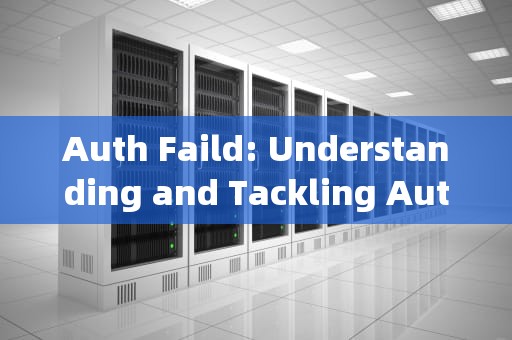In the digital age, where our lives are increasingly intertwined with online services, the importance of robust authentication mechanisms cannot be overstated. However, despite advancements in technology, "auth faild" (authentication failure) remains a common issue that plagues both users and service providers. This article delves into the intricacies of authentication failures, explores their causes, consequences, and provides actionable strategies to mitigate them.

What is Auth Faild?
Authentication failure occurs when a system or application denies access to a user due to incorrect credentials, such as a username and password combination, or due to other security checks failing. It's a critical component of cybersecurity, designed to protect sensitive data and resources from unauthorized access.
Common Causes of Auth Faild
1、Incorrect Credentials: The most prevalent reason for authentication failure is simply entering the wrong username, password, or both. This can happen due to typographical errors, forgotten passwords, or misunderstanding of case sensitivity rules.
2、Account Lockout: Many systems implement account lockout policies after several consecutive failed login attempts to prevent brute-force attacks. If a user exceeds the allowed number of attempts, their account may get temporarily locked out.
3、Password Expiry: To enhance security, organizations often enforce password expiration policies. If a user does not change their password within the specified period, they might face an authentication failure upon next login.
4、System Errors: Occasionally, technical glitches or server issues can lead to authentication failures. These could range from software bugs to hardware malfunctions or even network connectivity problems.
5、Two-Factor Authentication Issues: With the rise of two-factor authentication (2FA), failure to complete the second step of verification, such as not receiving a code via SMS or email, can result in an auth faild.
6、Account Compromise: If a user's credentials have been stolen through phishing attacks, malware, or other means, an unauthorized party may attempt to access the account, leading to failed attempts and potential lockouts.
7、Policy Violations: Some systems have specific access policies based on location, device type, or usage patterns. Violating these policies can trigger an authentication failure.
Consequences of Auth Faild
1、Disruption of Services: For users, auth faild means being unable to access necessary services, which can disrupt work, communication, or entertainment.
2、Security Risks: Frequent failed login attempts can signal a potential security threat, prompting administrators to investigate and potentially respond, which consumes resources and time.
3、User Frustration: Recurrent authentication failures can frustrate users, leading to decreased satisfaction and trust in the service provider.
4、Operational Inefficiency: For businesses, frequent authentication failures can slow down operations, impacting productivity and potentially leading to financial losses.
5、Increased Support Costs: Addressing authentication issues requires IT support intervention, which adds to operational costs and strains customer service resources.
Mitigating Auth Faild
1、Strong Password Policies: Encourage users to create strong, unique passwords and regularly update them. Implement complexity requirements and discourage reuse of passwords across multiple sites.
2、Multi-Factor Authentication (MFA): Introducing MFA adds an extra layer of security by requiring additional verification beyond just username and password. This significantly reduces the risk of unauthorized access even if credentials are compromised.
3、Account Recovery Options: Provide clear and secure methods for users to recover their accounts in case of forget their passwords or encounter other issues. This includes backup email addresses, security questions, or using recovery codes.
4、Regular Audits and Monitoring: Conduct regular audits of your authentication systems to identify vulnerabilities and monitor for suspicious activities. Implement real-time alerts for unusual login patterns or repeated failed attempts.
5、Educate Users: Educate users about best practices for password management, recognizing phishing attempts, and securing their devices. Awareness is key to preventing many common causes of authentication failures.
6、Improve User Experience: Simplify the authentication process without compromising security. Use adaptive authentication techniques that adjust the level of scrutiny based on contextual factors like user behavior, location, and device used.
7、Implement Account Unlock Strategies: Instead of permanent lockouts, consider implementing time-based or challenge-response mechanisms that allow users to regain access after a certain period or by answering security questions.
8、Regular Software Updates: Keep all authentication systems and related software up-to-date with the latest patches and updates to address known vulnerabilities.
9、Use Single Sign-On (SSO): SSO allows users to authenticate once and gain access to multiple applications, reducing the likelihood of credential fatigue and enhancing user convenience while maintaining security.
10、Employ Adaptive Authentication: This approach dynamically adjusts the authentication requirements based on risk assessment. For instance, if a login attempt is detected from an unfamiliar location or device, additional verification steps can be triggered.
Conclusion
Auth faild is an inevitable aspect of digital life but understanding its root causes and implementing effective mitigation strategies can significantly reduce its occurrence and impact. By adopting a multi-layered approach that combines strong password policies, MFA, education, and advanced technologies like adaptive authentication, organizations can strike a balance between security and user experience. As technology continues to evolve, staying vigilant and proactive in managing authentication processes will be crucial in safeguarding against unauthorized access and ensuring seamless user experiences.
随着互联网的普及和信息技术的飞速发展台湾vps云服务器邮件,电子邮件已经成为企业和个人日常沟通的重要工具。然而,传统的邮件服务在安全性、稳定性和可扩展性方面存在一定的局限性。为台湾vps云服务器邮件了满足用户对高效、安全、稳定的邮件服务的需求,台湾VPS云服务器邮件服务应运而生。本文将对台湾VPS云服务器邮件服务进行详细介绍,分析其优势和应用案例,并为用户提供如何选择合适的台湾VPS云服务器邮件服务的参考建议。

工作时间:8:00-18:00
电子邮件
1968656499@qq.com
扫码二维码
获取最新动态
